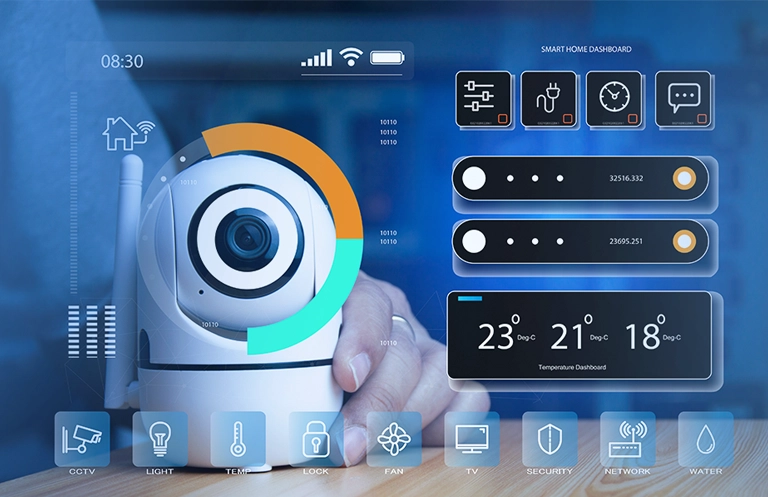As energy costs continue to spiral, one of the persistent demands of smart home consumers is lower utility bills. The smartest way to cut down the expense of managing home appliances as well as heating, ventilation and air-conditioned (HVAC) units is by leveraging remote-operated devices which help consumers save time, effort and energy in managing multiple devices.
A regular on/off switch can no longer bring in the desired levels of power efficiency – it’s more practical to use a smartphone app or a web tool which is closely integrated with all electrical devices and sensor interfaces. This is where wireless communication protocols become necessary to drive efficient communication between home appliances and the main server of house.
Some of the popular Ethernet protocols currently being used are BACnet, Z-Wave, ZigBee, Bluetooth and Wi-Fi. In this blog, I will discuss the specific advantages of building wireless home automation system networks based on ZigBee.

Why ZigBee is ideal for communication in home networks
ZigBee – a specification of high communication protocols uses small, low-power, low data rate digital radios based on IEEE 802.15.4 standards for wireless personal area networks, such as wireless headphones connecting with cell phones via short-range radio. The technology is intended to be simpler and cheaper than other WPANs, such as Bluetooth. ZigBee is targeted at radio-frequency (RF) applications which require a low data rate, long battery life, and secure networking.
For any system being used in home automation, the main goal is to reduce human effort by operating various appliances remotely. This is where the various parameters of ZigBee in Home Automation enable key benefits such as:
- Lighting control – Lighting controls play a central role in implementing the overall design of a wireless home automation system (WHAS) right from build to furnish stage. To provide this wireless automation facility, ZigBee network lends itself as more efficient as it depends on low power requirements. The lighting controls are achieved easily with faster access facility.
- Single touch without obstructions – Various domestic appliances can be controlled and operated using ZigBee according to control parameters and requirements. The data to operate the appliances can be sent via radio (ZigBee module) to the receiver (microcontroller) and based on that, relays will be controlled to operate the devices.
- One app to control everything – ZigBee helps achieve a system that can be integrated as a single portable unit allowing all of them to control lights, fans, air conditioners, television sets, security cameras, electronic doors, computer systems, audio/visual equipment’s etc. and turn on/off any appliance that is plugged into a wall outlet.
- 4.Security attributes of ZigBee – ZigBee in home automation leverages the security model of the IEEE 802.15.4 MAC sub layer which specifies the security services such as access control for devices to maintain a list of trusted devices within a network and data encryption
- Multi-source products – The standard specification for up to 254 nodes includes one master device managed from a single remote control. Practical usage examples of ZigBee includes home automation tasks such as turning lights on, setting the home security system, or starting the VCR. With ZigBee, all these tasks can be achieved from anywhere in the home at the touch of a button.
Zigbee and Smart Home Connectivity: Emerging Trends for the Future
The smart home industry is in a constant state of evolution, and Zigbee technology is at the forefront of enabling seamless connectivity among smart devices.
Enhanced Interoperability: Interoperability, or the ability of different devices and ecosystems to work together seamlessly, has been a longstanding challenge in the smart home ecosystem. However, there is a growing trend towards enhanced interoperability, driven in part by Zigbee technology. Initiatives like the Zigbee Alliance’s Project CHIP (Connected Home over IP) aim to create a standardized, open-source protocol that promotes unified communication between various devices and ecosystems.
Voice Assistant Integration: Voice assistants, like Alexa a have become central to every single smart homes. Zigbee is increasingly integrated into devices that work with these voice platforms, allowing users to control their Zigbee-enabled lights, thermostats, locks, and more using voice commands.
Energy Efficiency with Battery Life: One of Zigbee’s key strengths is its low-power consumption, making it an ideal choice for battery-operated devices like sensors and smart locks. In the coming years, there will be a continued emphasis on optimizing Zigbee devices for even greater energy efficiency, ensuring that battery-powered devices have longer lifespans between replacements or recharges.
Mesh Networking for Reliability: Zigbee’s mesh networking capability enhances the reliability of smart home networks. Devices communicate through a mesh of interconnected nodes, ensuring that signals can reach their destinations even if a device or connection point fails. This trend will persist, with more devices adopting Zigbee’s mesh networking for robust and dependable connectivity.
Integration of 5G and IoT: The rollout of 5G networks will definitely impact the smart home ecosystem. Zigbee’s compatibility with 5G and its ability to connect numerous low-power IoT devices will lead to increased adoption in smart homes. Expect to see more 5G-powered Zigbee devices and services in the coming years.
Enhanced Security: Security is a paramount concern in smart homes, and Zigbee has continually improved its security features. This includes providing end-to-end encryption, secure device onboarding, and robust protection against cyber threats.
Growing Device Ecosystem: The range of Zigbee-certified devices continues to expand, encompassing not only traditional smart home devices like lights and thermostats but also innovative products like smart appliances, health monitors, and environmental sensors.
DIY Smart Home Solutions: Zigbee’s user-friendly and cost-effective nature makes it an attractive choice for do-it-yourself (DIY) smart home enthusiasts. As more DIY-friendly Zigbee devices and ecosystems emerge, consumers will have greater flexibility and control over their smart home setups.
Conclusion
Enhanced interoperability, integration with voice assistants, energy efficiency, and security enhancements are among the trends that will continue to drive the adoption and growth of Zigbee in the coming years. As the smart home ecosystem matures, Zigbee’s flexibility and reliability make it a key enabler of the connected home of the future.
eInfochips offers expertise in sensor integration and wireless connectivity in ZigBee that drives interoperability for developing home automation solutions. We have deployed ZigBee as a Retail site intelligence (RSI) solution for one of our clients, which is one of the largest grocery chains in North America. To know more about eInfochips expertise in ZigBee implementation, email us at marketing@einfochips.com













